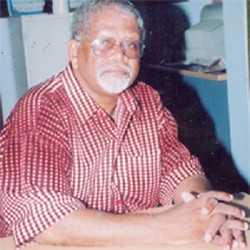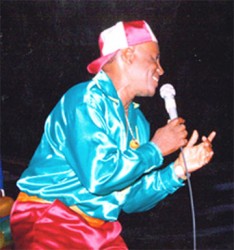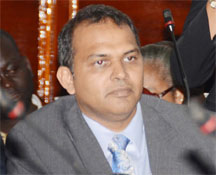Musical tradition has decided that Trinidad and Tobago is the “home” of the Calypso, that art-form that once outsiders defined as “a West Indian Song.”
The origins of calypso are somewhat varied but a common thread is that it has a base in African lament and rhythm. The Mighty Sparrow has a slow Calypso outlining it genesis amongst the African slaves who toiled on West Indian sugar plantations. Much has also been written detailing the art-form’s “French Connections.”
Origin apart, Trinidad became the acknowledged headquarters for the calypso and its exponents,

whether they were born in that twin-island State or not. What is not usually acknowledged or recognised is that Guyana, from the forties onwards, boasted top-flight calypsonians itself and that the Trinidadians used to travel to BG for shows but also to “test” their carnival compositions in Georgetown for style, content and general quality. An informal collaboration in calypso creation arose between Guyana’s calypsonians and the West Indian fellows. Lord Coffee, Thunder, Cobra, Panther, Lord Inventor, Fighter, Canary, et al, were respected by the Caribbean’s best between the forties and seventies.
But what has become of Guyana’s calypso today?
Mashramani – Then Decline
When I hear Barbadians and “Smaller-Island” calypsonians these days, I wonder about our own fellows who still love and attempt the art-form in Guyana. The Bajans and others have refined their art and packaged their kaisos and socas, as their Guyana counterparts seem to have been standing still.
But what has happened to Guyana’s Calypso? The Republican festival of Mashramani every February since 1970 provided some stimulus to the Calypso sector. Officialdom provided funding and impetus for the yearly Calypso Monarch Competitions. Even a Junior Category was introduced. Some very good songs and singers were discovered, emerged. But some deadening factor – or a combination of them- stilled the really excellent productions and Guyana retrogressed in the field of the calypso art-form, as the rest of the Region experimented, profitably, with original calypso, then all its hybirds.
I must repeat the history – and contention –I recounted elsewhere:

They all came here —- Sparrow, Blakie, Melody, Douglah, Francine, Rose, et al. They mixed with our Coffee, Cobra, Panther, Canary, Fighter, Intruder, Monica Chopperfield and the best of the pre-eighties exponents of that musical art-form which we then boasted. Dance bands like the Luckies, Washboards, Syncopators and greats like Harry Whittaker and James Smartt knew how to complement or improve our calypsonians offerings. Even if their backing assumed smaller, but expert dimensions. Then, the lyrics were witty, pointed and effective and the melodies simple, sweet and short enough to be catchy, even lasting. (And here I’m not even discussing the unique contribution and style of Shanto-Calypsonian Bill Rogers – a pioneer whose work was re-published for the last Carifesta Ten). Suffice to state that when the Trinidadian Calypso Bands and singers came here, they found a corps of locals who commanded their attention.
The reasons are varied and various, but Guyanese Calypso suffered qualitative setbacks by the late nineties. Of course, the seventies ushered in Mashramani festivals and their kaiso components, but economics, politics, migration, the rise of Jamaica’s reggae, Trinidad’s respect for the “Soul Calypso” – the so-ca— which international tourists and markets seem to prefer, and even the Bajan and “Small-Island” improvements, seem to influence the Guyana Calypso decline.
Mind you, a good Album was produced, in Barbados by Eddie Grant, of a collection of Guyanese Calyspo in the midst of the burgeoning slide. Late-seventies to late nineties saw gallant efforts and good songs from exponents like the veterans Canary, Intruder and, to some extent Lord-Eddie Hooper-Inventor; then folks such as El Cid, Hilton ‘Hitman’ Hemerding, Lenny Lancaster, Lurlene, Stella, Mighty Duke, Ayambo, Kendingo, Bright Colours, Winfield James, Blazing Fire, Mighty Limus and the Mighty Rebel, to mention a few. But the truth – and evidence – reveal a real decline as the 2000 millennium dawned.
Guyana calypso now…

Those concerned calypsonians left and a few defender-apologists will point to a few “explanations”: “lack of “sponsorship” after Mashramani, the intrusion of American tastes; the fusion challenges facing “pure” kaiso; no professional association, government’s indifference, very few good arrangers and bands.
Even if those “causes” are valid, I share my own views still. No I don’t read music, but I’ll contend I know a good calypso when I hear it. As distinct from the more popular “aerobic socas.” I feel myself to be a connoisseur of good calypso. (Like Canary, Hector, Cecil and his brother, ‘Father’ and a few other seniors still around…) So what is the problem?
It is my considered opinion that too many of today’s (would-be) calypsonians attempt too much in one calypso.
Too many words in one line; too many messages in one verse; making verses of choruses; and in a word, composing kaisoes that are too complex and fussy for appropriate arrangement, especially in the “hands” and capabilities of the inexperienced. There seems to be a mania for “Social Commentary” calypso. Buse the government even if the song is eminently forgettable.
One regular arranger explained that too many of today’s calypso aspirants are not too given to modifying their original compositions,” or even to taking general advice regarding the final musical product. Again, I’m not even referring to voice, ability to modulate and to utilise musical cues. (And I even experienced local exponents being indifferent to some Trinidadian veterans who were brought to advise.)
Good calypso that comes from innate creativity, assisted technical-professional expertise and appropriate motivational guidelines. But I know that cultural officialdom is full of concern and is having difficulties in being confident to allocate the millions they now do, only to experience calypso mediocrity.
The Ministry of Culture and calypso
Guyana’s current Minister of Culture is worried about the art –form but he is prepared to give the taxpayers’ monetary blessings to salvage and sustain the really committed calypso singers.
He is aware that the Junior Calypso competitions are not producing enough competent graduates to the (dubious) senior level. There is again need for a gathering of calypsonians, arrangers, musicians, judges and, perhaps, respected acceptable Trinidadian Calypso veterans for one intense inter-active workshop.
Practical sessions, it is hoped, will assist young and old to appreciate how to compose; to appreciate the arrangers and musicians’ roles, criteria for judging, the difference between pure calypso and its off-shoot, the soca.
Will it work? Will they listen? It remains to be seen. What is certain is that the Minister and many of his Mashramani management colleagues are in consonance that something drastic needs to be done to salvage calypso, chutney, soca and masquerade. Expert as they are, I know that my favourites, Rebel, D’Ivan and Black Hat will listen. Even Slingshot and Canary might attend, I guess.
Meanwhile, the Trinidadians are also battling to keep the art-from alive – if not “pure”. The tents are struggling to keep up with the Chutney, Soca and Reggae/Dance-Hall “invasions”; the small islands are forging ahead with their calypsos and Jamaica’s reggae has supplemented calypso internationally.
So yes, calypso is in trouble elsewhere. However, it is an art-form that identifies many of us in these parts. Others can expound about what calypso is and does. I conclude by hoping for calypso’s resurgence. Right here.
Meetings of Guyana calypsonians, musicians, arrangers and sponsors – are in order if hope is to be kept alive. The other burning of course, always hovers: are Guyana’s calypsonisns incapable of organising themselves for year-long activity.




